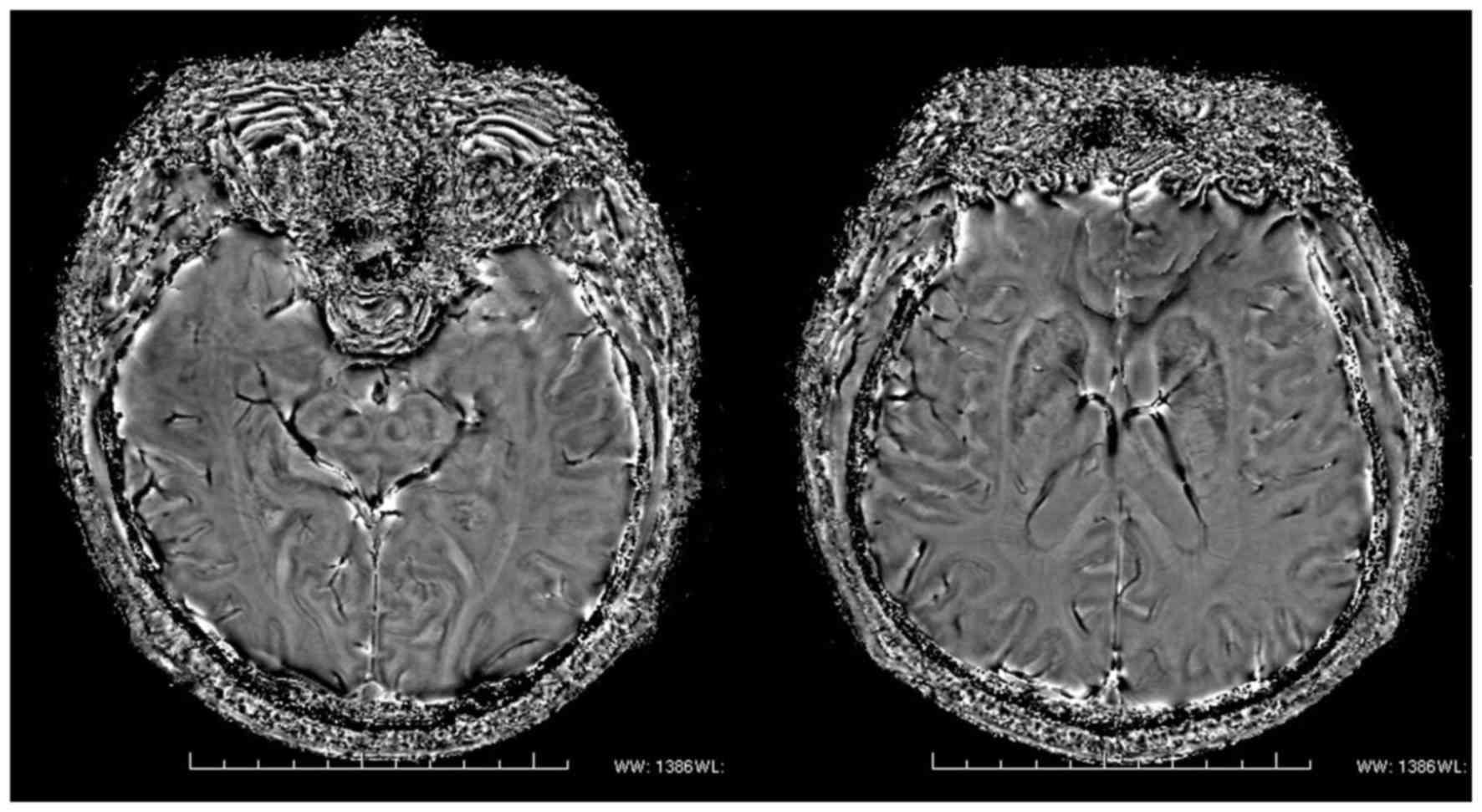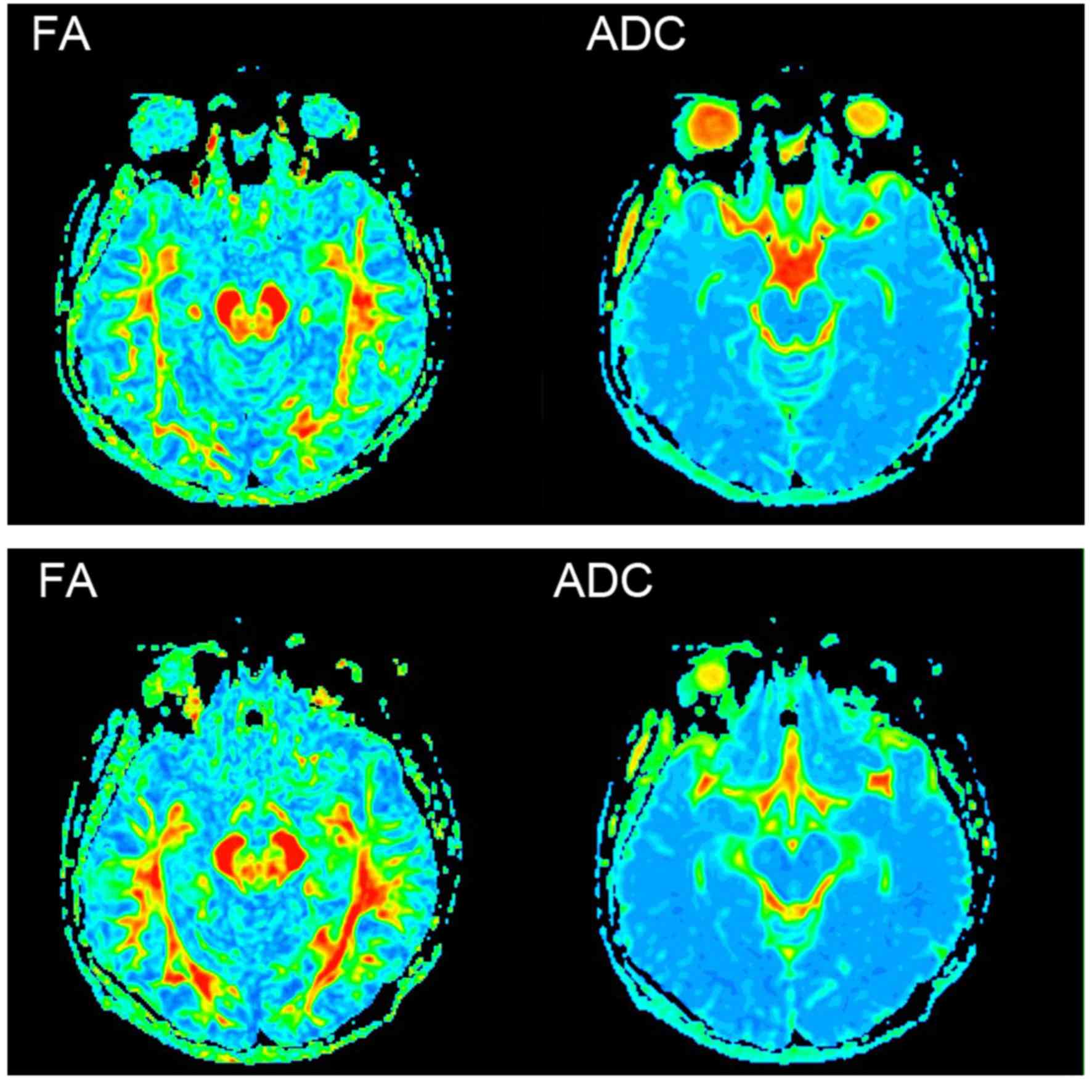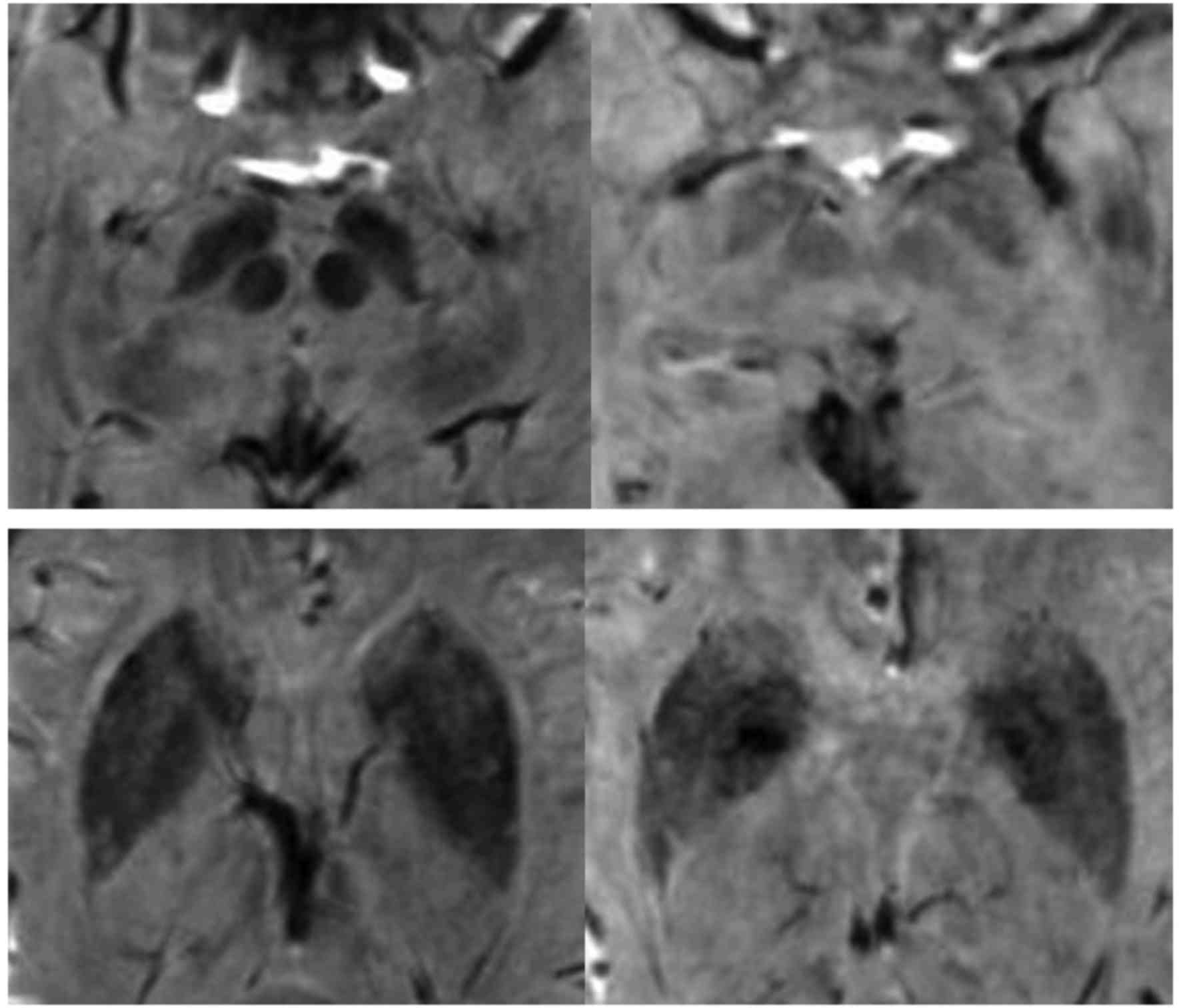|
1
|
Chen S, Tan HY, Wu ZH, Sun CP, He JX, Li
XC and Shao M: Imaging of olfactory bulb and gray matter volumes in
brain areas associated with olfactory function in patients with
Parkinson's disease and multiple system atrophy. Eur J Radiol.
83:564–570. 2014. View Article : Google Scholar : PubMed/NCBI
|
|
2
|
Aquino D, Contarino V, Albanese A, Minati
L, Farina L, Grisoli M, Romita L, Elia AE, Bruzzone MG and
Chiapparini L: Substantia nigra in Parkinson's disease: A
multimodal MRI comparison between early and advanced stages of the
disease. Neurol Sci. 35:753–758. 2014. View Article : Google Scholar : PubMed/NCBI
|
|
3
|
Ekman U, Eriksson J, Forsgren L, Mo SJ,
Riklund K and Nyberg L: Functional brain activity and presynaptic
dopamine uptake in patients with Parkinson's disease and mild
cognitive impairment: A cross-sectional study. Lancet Neurol.
11:679–687. 2012. View Article : Google Scholar : PubMed/NCBI
|
|
4
|
Youn J, Lee JM, Kwon H, Kim JS, Son TO and
Cho JW: Alterations of mean diffusivity of pedunculopontine nucleus
pathway in Parkinson's disease patients with freezing of gait.
Parkinsonism Relat Disord. 21:12–17. 2015. View Article : Google Scholar : PubMed/NCBI
|
|
5
|
Le W: Role of iron in UPS impairment model
of Parkinson's disease. Parkinsonism Relat Disord. 20:158–161.
2014. View Article : Google Scholar
|
|
6
|
Wu SF, Zhu ZF, Kong Y, Zhang HP, Zhou GQ,
Jiang QT and Meng XP: Assessment of cerebral iron content in
patients with Parkinson's disease by the susceptibility weighted
MRI. Eur Rev Med Pharmacol Sci. 18:2605–2608. 2014.PubMed/NCBI
|
|
7
|
Tae-Hyoung Kim and Jae-Hyeok Lee: Serum
uric acid and nigral iron deposition in Parkinson's disease: A
pilot study. PLoS One. 9:112512–112515. 2014. View Article : Google Scholar
|
|
8
|
Zhang ZX, Roman GC, Hong Z, Wu CB, Qu QM,
Huang JB, Zhou B, Geng ZP, Wu JX, Wen HB, et al: Parkinson's
disease in China: Prevalence in Beijing, Xian, and Shanghai.
Lancet. 365:595–597. 2005. View Article : Google Scholar : PubMed/NCBI
|
|
9
|
Prakash BD, Sitoh YY, Tan LC and Au WL:
Asymmetrical diffusion tensor imaging indices of the rostral
substantia nigra in Parkinson's disease. Parkinsonism Relat Disord.
18:1029–1033. 2012. View Article : Google Scholar : PubMed/NCBI
|
|
10
|
Hodaie M, Neimat JS and Lozano AM: The
dopaminergic nigrostriatal system and Parkinson's disease:
Molecular events in development, disease and cell death, and new
therapeutic strategies. Neurosurgery. 60:17–30. 2007. View Article : Google Scholar : PubMed/NCBI
|
|
11
|
Li W, Liu J, Skidmore F, Liu Y, Tian J and
Li K: White matter microstructure changes in the thalamus in
Parkinson disease with depression: A diffusion tensor MR imaging
study. AJNR Am J Neuroradiol. 31:1861–1866. 2010. View Article : Google Scholar : PubMed/NCBI
|
|
12
|
Vaillancourt DE, Spraker MB, Prodoehl J,
Abraham I, Corcos DM, Zhou XJ, Comella CL and Little DM:
High-resolution diffusion tensor imaging in the substantia nigra of
de novo Parkinson disease. Neurology. 72:1378–1384. 2009.
View Article : Google Scholar : PubMed/NCBI
|
|
13
|
Zhang J, Zhang Y, Wang J, Cai P, Luo C,
Qian Z, Dai Y and Feng H: Characterizing iron deposition in
Parkinson's disease using susceptibility-weighted imaging: An in
vivo MR study. Brain Res. 1330:124–130. 2010. View Article : Google Scholar : PubMed/NCBI
|
|
14
|
Berg D and Hochstrasser H: Iron metabolism
in Parkinsonian syndromes. Mov Disord. 21:1299–1310. 2006.
View Article : Google Scholar : PubMed/NCBI
|
|
15
|
Martin WR, Wieler M and Gee M: Midbrain
iron content in early Parkinson disease: A potential biomarker of
disease status. Neurology. 70:1411–1417. 2008. View Article : Google Scholar : PubMed/NCBI
|
|
16
|
Pereira JB, Svenningsson P, Weintraub D,
Brønnick K, Lebedev A, Westman E and Aarsland D: Initial cognitive
decline is associated with cortical thinning in early Parkinson
disease. Neurology. 82:2017–2025. 2014. View Article : Google Scholar : PubMed/NCBI
|
|
17
|
Chan LL, Rumpel H, Yap K, Lee E, Loo HV,
Ho GL, Fook-Chong S, Yuen Y and Tan EK: Case control study of
diffusion tensor imaging in Parkinson's disease. J Neurol Neurosurg
Psychiatry. 78:1383–1386. 2007. View Article : Google Scholar : PubMed/NCBI
|
|
18
|
Yoshikawa K, Nakata Y, Yamada K and
Nakagawa M: Early pathological changes in the parkinsonian brain
demonstrated by diffusion tensor MRI. J Neurol Neurosurg
Psychiatry. 75:481–484. 2004. View Article : Google Scholar : PubMed/NCBI
|
|
19
|
Inoue T, Ogasawara K, Beppu T, Ogawa A and
Kabasawa H: Diffusion tensor imaging for preoperative evaluation of
tumor grade in gliomas. Clin Neurol Neurosurg. 107:174–180. 2005.
View Article : Google Scholar : PubMed/NCBI
|
|
20
|
Galvin JE, Lec VM and Trojanowske JQ:
Synucleinopathies: Clinical and pathological implications. Arch
Neurol. 58:186–190. 2001. View Article : Google Scholar : PubMed/NCBI
|
|
21
|
Lang AE and Mikulis D: A new sensitive
imaging biomarker for Parkinson disease? Neurology. 72:1374–1375.
2009. View Article : Google Scholar : PubMed/NCBI
|
|
22
|
Nicoletti G, Tonon C, Lodi R, Condino F,
Manners D, Malucelli E, Morelli M, Novellino F, Paglionico S, Lanza
P, et al: Apparent diffusion coefficient of the superior cerebellar
peduncle differentiates progressive supranuclear palsy from
Parkinson's disease. Move Disord. 23:2370–2376. 2008. View Article : Google Scholar
|
|
23
|
Schocke MF, Seppi K, Esterhammer R,
Kremser C, Mair KJ, Czermak BV, Jaschke W, Poewe W and Wenning GK:
Trace of diffusion tensor differentiates the Parkinson variant of
multiple system atrophy and Parkinson's disease. Neuroimage.
21:1443–1451. 2004. View Article : Google Scholar : PubMed/NCBI
|












